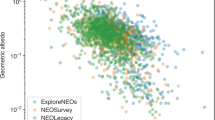Abstract
The contribution to the brightness of the infrared background by asteroidal dust, distinguished both by lower color temperature and ‘band-pair’ morphology, is determined using IRAS observations. Dust band pairs are associated with at least 7 asteroid families and groups, but very little is detected from the remainder of the asteroid belt, indicating that asteroid families and groups are the source of asteroidal dust.
Access this chapter
Tax calculation will be finalised at checkout
Purchases are for personal use only
Preview
Unable to display preview. Download preview PDF.
Similar content being viewed by others
References
Dermott, S.F., Nicholson, P.D., Burns, J.A., and Houck, J.R. (1984) ‘Origin of the Solar System dust bands discovered by IRAS’, Nature 312, 505.
Grün, E., Zook, H. A., Fechtig, H., and Giese, R.H. (1985) ‘Collisional balance of the meteoritic complex’, Icarus 62, 244.
Hauser, M.G. (1988) ‘Models for infrared emission from zodiacal dust’, in A. Lawrence (ed.), Comets to Cosmology, Springer-Verlag, Berlin, pp. 27–39.
Low, F.J. et al. (1984) ‘Infrared cirrus: New components of the extended infrared emission’, Ap. J. 278, L19.
Reach, W.T. (1988) ‘Zodiacal emission I. Dust near the Earth’s orbit’, Ap. J. 335, 468.
Reach, W.T. (1991) ‘Zodiacal emission II. Dust near the Ecliptic’, Ap. J. 387, in press.
Reach, W.T. and Heiles, C. (1988)’ Separating the Solar System and Galactic contributions to the diffuse infrared background’, in A. Lawrence (ed.), Comets to Cosmology, Springer-Verlag, Berlin, pp. 40–43.
Sykes, M.V. (1988) ‘IRAS observations of extended zodiacal structures’, Ap. J. 334, L55.
Sykes, M.V. (1990) ‘Zodiacal dust bands: Their relation to asteroid families’, Icarus 84, 267.
Valsecchi, G.B., Carusi, A., Knezevic, Z., Kresak, L., and Williams, J.G. (1989) ‘Identification of asteroid families’, in R.P. Binzel, T. Gehrels, and M.S. Matthews (eds.), Asteroids II, University of Arizona Press, Tucson, pp. 368–385.
Author information
Authors and Affiliations
Editor information
Editors and Affiliations
Rights and permissions
Copyright information
© 1991 Springer Science+Business Media Dordrecht
About this paper
Cite this paper
Reach, W.T. (1991). Asteroidal Dust and the Zodiacal Emission. In: Levasseur-Regourd, A.C., Hasegawa, H. (eds) Origin and Evolution of Interplanetary Dust. Astrophysics and Space Science Library, vol 173. Springer, Dordrecht. https://doi.org/10.1007/978-94-011-3640-2_44
Download citation
DOI: https://doi.org/10.1007/978-94-011-3640-2_44
Publisher Name: Springer, Dordrecht
Print ISBN: 978-94-010-5616-8
Online ISBN: 978-94-011-3640-2
eBook Packages: Springer Book Archive




